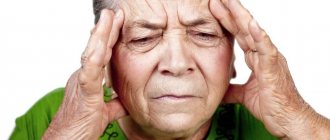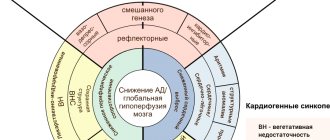Fainting (an outdated medical name is syncope) is a condition characterized by loss of consciousness and a drop in blood pressure. Metabolism slows down, sudden weakness and confusion occur. Fainting can last from a few seconds to tens of minutes.
In most cases, fainting is caused by a sudden decrease in metabolism in the brain, cerebral circulation is disrupted, and the brain stops receiving enough oxygen. Despite the fact that the brain does not function at full capacity, basic vital functions are reduced, but do not disappear completely. The patient is breathing, the heart is working.
Loss of consciousness can be caused by a variety of diseases. Sometimes fainting occurs due to a coincidence of circumstances - fatigue, stuffiness, prolonged fasting.
Before fainting, there is always a pre-fainting state, which can also last from a few seconds to several minutes. In some cases, it is enough for the patient to sit or lie down and relax the collar to avoid fainting.
Presyncope is characterized by the following symptoms:
- pulsation in temples;
- difficulty breathing - a subjective feeling of lack of oxygen;
- increased sweating;
- feeling of heat throughout the body;
- nausea, dizziness;
- tachycardia, feeling of rapid heartbeat;
- the appearance of dark spots before the eyes.
If the patient fails to sit down, he faints. In most cases, patients quickly come to their senses without outside help (although this does not mean that it does not need to be provided). Sometimes after fainting, other unpleasant symptoms are observed, for example, trembling and involuntary twitching of the limbs, the urge to urinate.
At CELT you can get advice from a neurologist.
- Initial consultation – 4,000
- Repeated consultation – 2,500
Make an appointment
Causes of fainting
There are several physiological reasons that can lead to short-term loss of consciousness. Let's look at some of them.
- Disturbances in the functioning of the autonomic nervous system. This system is responsible for vascular tone. If there is a malfunction, it cannot correctly give commands to the vessels, they contract sharply, and loss of consciousness occurs. This is the main cause of neurogenic fainting - the most common fainting.
- Diseases of the cardiovascular system. They are the cause of the so-called. cardiogenic syncope. The heart does not work well enough, the blood vessels narrow, which leads to brain hypoxia.
- Atherosclerosis and vascular diseases. This also includes ischemic attacks and strokes.
- Increased intracranial pressure. It occurs as a consequence of certain diseases - a tumor, congenital hydrocephalus, or against the background of cerebral hemorrhage, as well as after head injuries.
- Decreased blood glucose, decreased oxygen concentration in tissues. Such conditions occur with diabetes, anemia, kidney and liver failure.
- As a result of a decrease in the volume of fluid circulating in the body. May be the result of bleeding, diarrhea, or other excess fluid loss.
- Poisoning by toxins: carbon monoxide, ethyl alcohol and others.
- As a result of various psychological and psychiatric diseases. For example, with neuroses and anxiety, a common symptom is hyperventilation. The body tries to control the oxygen content, which leads to vascular spasm. In such cases, patients need to learn breathing techniques.
There are other reasons: infectious diseases, traumatic brain injuries, epilepsy attacks. In each individual case, it is necessary to undergo an examination to find out why fainting occurs.
If this is an isolated case, and there were no pathologies during medical examinations before, there is no need to worry. But if fainting recurs, you need to visit a neurologist.
Our doctors
Novikova Larisa Vaganovna
Neuropathologist, Candidate of Medical Sciences, doctor of the highest category
Experience 39 years
Make an appointment
Pankov Alexander Rostislavovich
Neurologist
40 years of experience
Make an appointment
Types of fainting
The classification of fainting is based on the causes of loss of consciousness. There are three main types of fainting:
- neurogenic;
- cardiogenic;
- hyperventilation.
Among neurogenic syncope, in turn, a distinction is made between vasodepressor and orthostatic. The first ones are the most common, usually occurring in fairly young patients in stuffy conditions, stress, fatigue, or lack of nutrients.
Orthostatic fainting occurs when there is a sudden change in body position (usually during a sudden rise or standing). It may also be caused by taking certain medications.
Cardiogenic loss of consciousness occurs when the heart rhythm is abnormal and can accompany a heart attack. Cardiogenic syncope accounts for up to a quarter of all cases of loss of consciousness, especially among the elderly population.
Hyperventilatory syncope occurs due to rapid breathing. This symptom is characteristic of panic attacks and anxiety attacks. Sometimes this condition is called a vegetative crisis.
What is a hungry faint?
Hunger faint is a loss of consciousness for a short period of time, occurring due to lack of blood circulation in the brain. Simply put, due to a deficiency of nutrients supplied from outside and oxygen starvation (so-called hypoxia).
The causes and symptoms of this condition may vary. And the problem of hungry fainting usually affects women who are chasing an ideal figure and are on a diet.
Development mechanism
Slightly different in each case. For example:
- in case of fainting caused by heart rhythm disturbances (certain types of arrhythmias), there is less blood in the cerebral vessels, since “incorrect” heart contractions pump a smaller volume;
- with orthostatic fainting, which develops when a person stands up abruptly, the smaller volume of blood is due to a change in body position to which the vessels have not yet had time to adapt;
- with fear or anxiety, a person begins to breathe more often, which causes a decrease in carbon dioxide pressure in his blood; because of this, the brain vessels dilate;
- Abdominal pain is also a cause of loss of consciousness. In this case, the brain vessels are less filled with blood due to excessive stimulation of the vagus nerve.
Clinical picture
Fainting is characterized by rapid development. Loss of consciousness occurs rapidly. Sometimes patients don’t even have time to realize that something is wrong. In other cases, typical symptoms of presyncope are observed.
Fainting is characterized by the following clinical manifestations:
- lack of consciousness;
- weak pulse;
- decreased breathing rate (bradypnea);
- lack of pupillary reaction to light;
- the patient comes to his senses within 1-5 minutes (if fainting lasts longer, this is serious);
- after fainting, pallor and weakness persist;
- for some time afterward, low blood pressure is observed;
- Dizziness and nausea may occur.
In most cases, syncope occurs when the patient is in an upright position. If the patient loses consciousness while lying down, then it is necessary to suspect a serious somatic pathology.
Diagnostic measures
MRI of the brain
- Cost: 14,000 rub.
More details
Diagnosis begins with an initial appointment with a neurologist. First, the doctor will try to find out in what circumstances, under the influence of what provoking factors, loss of consciousness develops. To establish a final diagnosis, you will need to undergo a series of instrumental examinations.
Thus, if cardiogenic fainting is suspected, the patient is referred for an ECG, echocardiography, and also for consultation with a cardiologist. If epilepsy is suspected, an electroencephalogram is performed. It is also common to take a blood sample to check blood sugar levels to rule out hypoglycemia. If anemia is suspected, it is necessary to conduct a blood test for hemoglobin content. If there is a possibility of neurological or organic diseases of the brain, then MRI and/or vascular examination are prescribed.
Treatment is carried out on an outpatient basis; it is enough to undergo an examination and receive treatment prescriptions.
Loss of consciousness, panic attacks, apathy, fear, neurosis
1784 views
March 25, 2019
Hello! I had a lot of stress throughout the year, I was nervous every evening at home. My chest was aching and my heart was squeezing. I didn't want to communicate with anyone. Work was no longer a joy. My vision began to deteriorate sharply. My memory began to noticeably deteriorate. In the summer I had panic attacks. Those. We were at the dacha and I was overcome by wild fear. Six months ago I experienced a series of blackouts. In one day I had the urge five or six times, but I managed to sit on the sofa in time, breathe deeply, and open the window. Then everything stopped - I began to live a normal life. I am a driver - I go to the doctor every day. Half a year passed... I went into the office. It was stuffy. I took off my outerwear and sat down at the chair. And then I felt like I was going to crash. I reached the kitchen, where no one was there. Sat on a chair. I woke up on the floor. I went to a neurologist. First, he sent me to an epileptologist - epilepsy was ruled out. Then to a psychotherapist - he recommended Phenazepam and Valdoxan. Then my doctor prescribed the following studies: ECG (normal), EEG, REG (normal), MRI of the brain (conclusion: single vasogenic focus of the right frontal lobe of the brain), MR angiogram of cerebral vessels (conclusion: right VA of small diameter Hypoplasia of the A1 segment of the right ACA. Photo attached). Tablets: Carbamazepine 1t at night - 30 days; Mexidol 1t/2 times a day - 30 days; Asparkam 1t/3 times a day - 30 days; Actovegin 1t/3 times a day - 14 days; Combilipen 1t/3 times a day for 14 days; Fluoxetine 1t in the morning - 3 months; Grandaxin 1t/3 times a day - 30 days; MagneB6 Forte 1t/3 times a day - 30 days; Phenazepam 1 tablet at night - 30 days; Valdoxan 1t at night - 30 days. Injections: Magnesia 5 pieces. For two months I felt more or less normal. But recently, when I went into the store, I felt that I was getting sick again and felt dizzy. I went outside, took a breath, and felt a little better. I wanted chocolate and Pepsi-Cola. Chocolate helped. (My normal sugar level is 5.4 - 6.1). The day before yesterday, again, when I went into the store, I almost lost consciousness - I sniffed ammonia in time and went out into the street. For the last two weeks, my legs have been weak, weakness, apathy, no desire to communicate with anyone, incomprehensible fear. I was treated for two months, I thought that everything was fine, but again everything started all over again. And nothing provoked these actions. I'm a driver and I'm afraid to go to work. Who else can I contact and what studies and tests should I take? Thank you!
The question is closed
First aid for fainting
It is important to know how to provide first aid if you lose consciousness.
- The patient must be placed on his back with the lower extremities elevated.
- Unbutton your collar, loosen your tie, remove your scarf, and provide fresh air.
- To speed up the return to consciousness, you can sprinkle the patient with cold water. For the same purposes, it is recommended to use ammonia.
If the patient does not come to within 2-3 minutes, you must call an ambulance. With prolonged fainting, even after returning to consciousness, the patient may experience some dysfunction.
Fainting should be treated by qualified professionals. Neurologists at the CELT clinic are ready to carry out all the necessary diagnostics and prescribe the most effective treatment. Modern equipment and highly qualified doctors are the key to patient health.
Make an appointment through the application or by calling +7 +7 We work every day:
- Monday—Friday: 8.00—20.00
- Saturday: 8.00–18.00
- Sunday is a day off
The nearest metro and MCC stations to the clinic:
- Highway of Enthusiasts or Perovo
- Partisan
- Enthusiast Highway
Driving directions
Treatment
Hungry fainting can be treated non-medically. Therapy consists of rational nutrition in small portions 4-5 times a day to maintain the amount of glucose in the blood at a certain level. It is necessary to maintain a balanced diet. The number of calories should be calculated according to the daily load, but not less than 1400 kcal/day (basal metabolic rate). Proteins should make up 30-35%, fats – 15-20%, carbohydrates – 40-50% of daily nutrition.
First aid for hungry fainting
It is necessary to provide first aid as soon as possible in case of hungry fainting. Syncope itself is not dangerous. But falling while losing consciousness can lead to injury. In addition, residual neurological impairment is possible due to brain hypoxia during hungry syncope. What to do if a person falls and lies unconscious due to lack of nutrition? The following actions need to be taken:
- All clothing on the patient should be unbuttoned to ensure an influx of oxygen.
- The patient should be placed so that the legs are higher than the body.
- The head is turned to the side so that the tongue does not sink in and block the airway.
- Then you need to let the cotton wool soaked in ammonia smell. If there is no such medicine, then you can rub your temples vigorously with a solution of vinegar or cologne. You can also help the patient by pressing forcefully on the area of the face between the nose and upper lip.
- As soon as the person regains consciousness, he should be given sweet tea or coffee to drink. After 30 minutes the patient must be fed.
Find out: how to administer first aid for fainting










